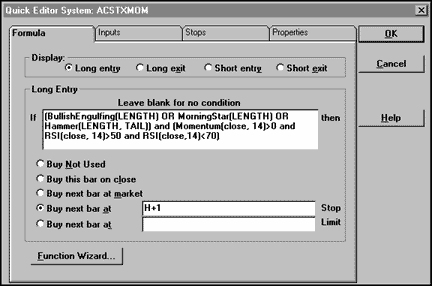NEW TECHNIQUES
Candlestick Filtering
by Rudy Teseo
Using candlestick patterns alone to generate buy and sell signals may be risky. Combining them with confirming indicators can greatly increase reliability. Take a look.
Few candlestick patterns can stand alone without confirmation of some kind. It is extremely risky to trust buy and sell signals based solely on these patterns. You can diminish some of the uncertainty, though, by filtering the candlesticks' signals, using other indicators to confirm buy or sell signals.

FIGURE 1: GOING LONG. Rules for going long from a combination of bullish candlestick formations and rising RSI are spelled out in a SuperCharts system. Substituting other indicators for RSI or momentum is worth exploring.
In the case of candlesticks, the question arises: What to use for confirmation? For an answer, consider this: candlestick patterns are merely a different form of chart pattern. Candlesticks and standard price bars display exactly the same information -- open, high, low, and close. Therefore, any indicators you are currently using on bar charts can be used to confirm the candlestick pattern. This is the essence of my filtering process.
As an example, I tested a system that I found in Stuart Evens' article in the August 1999 STOCKS & COMMODITIES. Momentum and the relative strength indicator (RSI) make good companion confirmation indicators to candlesticks. All that is necessary is to select indicator parameters that support and confirm each other and also filter the candlesticks. Backtesting helps finetune the parameters.
COMBINATIONS
There are approximately 65 candlestick patterns and more than a dozen indicators that could be used for confirmation, so there could be hundreds of possible combinations. I used three bullish patterns (bullish engulfing, morning star, and hammer) and three bearish patterns (bearish engulfing pattern, evening star, and dark cloud cover). Some candlestick chartists maintain that the morning star and dark cloud cover patterns require no confirmation, but until my own backtesting verifies this, I'll continue to use confirmation indicators.
I developed a trading system in two parts: a setup and an entry. The setup is a combination of conditions that must be met to set the stage for a possible entry into the market. This initiates the "ready-aim" mode. The entry is the set of conditions that must exist to actually execute a trade. This is the "fire" mode. Here is the plain-language formula for a long entry system:
Setup: If a bullish engulfing pattern or a morning star or a hammer appears and momentum is greater than zero, and RSI is greater than 50 and less than 70, then:
Entry: Buy the next bar at today's high, plus $1.00 stop.
Rudy Teseo is a retired communications and computer consultant. He has also taught courses in investing and options trading. He may be reached via E-mail at Rftess@juno.com.
Excerpted from an article originally published in the December 1999 issue of Technical Analysis of STOCKS & COMMODITIES magazine. All rights reserved. © Copyright 1999, Technical Analysis, Inc.
Return to December 1999 Contents